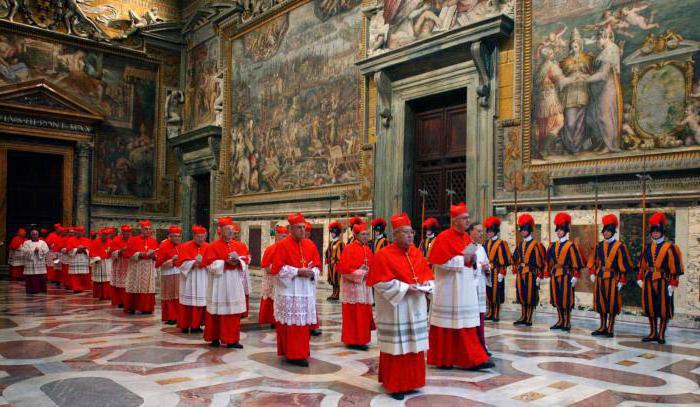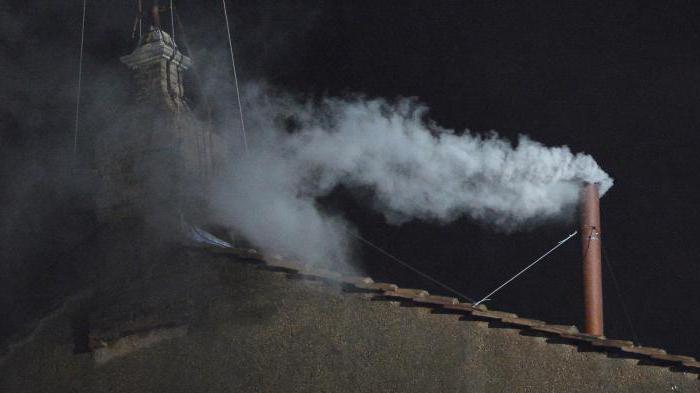In the history of mankind there are a lot of interesting, fascinating, amazing. There are facts and events whose proof of the truth is almost impossible due to the lack of written sources. Others are well documented and studied. Take an event like a conclave. It only seems that the election of the Pope in different periods of history is fully explored, all secrets are revealed. In fact, this process is quite interesting for the general public. And some even believe that the conclave is the first known case of the development of bureaucratic rules and procedures. Quite possibly. Let's briefly describe this event, and how to evaluate it, decide for yourself.
What is a conclave
To begin with, those who have not previously encountered this concept, we will give a definition. “The Conclave” is the term that refers to a special meeting of cardinals after the death of another pontiff. The purpose of the event: the election of the next head of the Catholic world. The rules of the conclave have evolved over time, changed them many times. However, the essence remained unchanged. The meaning of the word “conclave” is probably best conveyed by what is happening. It is translated from Latin as “locked room”. The election process is strict. Cardinals are isolated from society. They are forbidden to use any means of communication during the conclave, to talk with outsiders. It is believed that the election of the pontiff is a religious act. Cardinals should consult only with the Lord, determining the most worthy. And so that there would be no temptations and intrigues, which history knew a lot, the process was carefully watched by specially appointed church officials.

Event outline
Let's describe how the pontiff is currently selected. It is important to understand that the procedure has undergone changes over the centuries. And they were associated with various circumstances. When the Pope dies , the throne is vacant. Not earlier than fifteen days from the date of his release, but not later than twenty, the conclave is assembled. History does not know cases when this rule was violated. Only cardinals who are not yet eighty years old now take part in the elections. Their total number should not exceed one hundred and twenty people. Electors with accompanying persons are lodged in the Vatican, in the house of St. Martha. And the voting procedure is always held in one place: in the Sistine Chapel. Cardinals are locked in this room. At first they all pray together, and then they try to make a choice. Papa is the one who scored a third and one vote of all participants. Each is given a newsletter. Cardinals write the name of the chosen one on it and throw it in a special urn, adhering to the principle of seniority. That is, the one who is more than all years old is the first to vote. Approaching the urn, everyone takes an oath: "Witness Christ the Lord, who will judge me, that I choose the one who, according to God, should be chosen."

Vote count
Many have heard the parable of the smoke that signals the world about the election of a new Pope. This is not fiction. Indeed, ballots are burned after the procedure is completed. But not always smoke announces a new pontiff. There is a strict rule: the number of ballots must match the number of those present. That is, they get it and recount. If it does not converge, then everyone is burned. In this case, the smoke is made specially black (using straw or chemicals). This is a sign of an unsuccessful attempt. Upon completion, the following is carried out. And everything with counts is repeated again. Voting can last three days. In the first, only one round is carried out, in the subsequent four are allowed. If it is impossible to choose a pontiff, after three days of work, the two most popular candidates are determined. The winner is determined by a simple majority.
The final stage
The chosen pontiff must publicly, among the cardinals, accept authority. This person is asked with the question: “Do you accept the canonical choice of you as the High Priest?” Having received an affirmative answer, they suggest that the new Pope determine his name. Only after this is the procedure considered complete. Ballots are burned, signaling believers about the success of the election with white smoke. Now the procedure is accompanied by the ringing of bells. The pontiff is removed to a special room, where he must choose a white cassock from three pre-cooked, different sizes. Electors are awaiting his return to the Sistine Chapel to pay homage and obedience.
Conclave: Reforms
The process of electing a pontiff has often come to a standstill. This happened even when strict rules did not exist. Believers had to repeatedly lock the cardinals, refuse food in order to stimulate their activity. Blessed Pope Gregory X issued a special document, which introduced the isolation of electors from society. Ballots and the voting procedure were approved by Pius IV in 1562. The reform of the process was continued by Pope Gregory XV. He issued bulls that govern ceremonies and election standards. The conclave venue was officially established in the fourteenth century. The most recent document, repealing all previous rules, was signed by Pope John Paul II. Its constitution determines that the conclave is the only way to elect a pontiff.
Exceptional Cases
As a rule, the Pope has power until the last breath. History knows only two cases of voluntary abandonment of this highest position. The first Forsaken was Gregory XII (1415). This event occurred during a deep schism in the church. In those days there were two pontiffs who tore the flock. Gregory XII promised that he would leave the throne if his competitor did the same. The oath had to be fulfilled for the sake of peace in the religious community. The next abdication occurred recently, in 2013. Benedict XVI reported that his health condition did not allow him to serve properly. In these two cases, the conclave was assembled with a living pontiff who refused dignity.
Who can become a pope?
You know, the pontiff has tremendous power. In past centuries, it was rightfully considered unlimited. They just do not appoint such a position. Today, candidates are selected from the cardinals. But it was not always so. In 1179, the Third Lateran Council established that any unmarried Catholic man can apply for a position. Urban VI, subsequently elected by the Pope, was not a cardinal. It is necessary to understand what the conclave means for believers. We mentioned that ordinary people influenced the course of elections. The fact is that for Catholics it is very important to know that they have a chapter, that is, a representative of the Lord on earth. Without the Pope, believers feel like children without a father, and even scold sloppy cardinals. Hence the tradition with smoke - a joyful signal for many people. This is a joyful event for Catholics, giving them hope that they are protected from devilish machinations and other indecency.